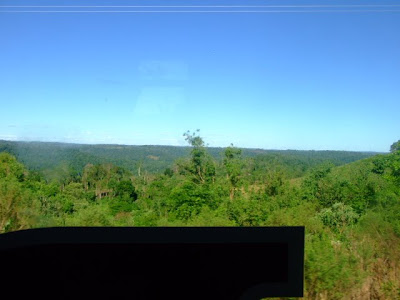..Then we caught yet another omni-bus, this time destined for San Ignacio, where we were to discover the very impressive ruins of one of the Jesuit missions that were built in this region from the 1600s... Our omnibus seats this time were up the top and right at the front so we had a pretty unique view of the journey:
We were met, as we disembarked in San Ignacio, by our very enthusiastic hostel owner, who kindly led us to his little truck, a noisy bomb of a thing with only one door that opens or closes properly. Hero and Dan rode in the back with the doors open for a view of the neighbourhood. Our hostel was a unique place, as it was only big enough for one family, and the people who ´ran´ it were all artesans, who worked in a kind of collective model across the road. We set off after settling in and saying hello to the other dwellers camping out the back - towards the ruins, just up road, truly the centre of the town... what we were hoping to see was a show that we´d heard lots of good things about which told the history of the mission and its ultimate ruin. It was on, as it is every night if there´s no rain, and we weren´t disappointed!!
They used projections in the most creative and integrated ways i´ve ever seen:
a ¨Narrator¨ first appeared projected (and therefore wrapped around) a tree trunk. He would reappear projected onto walls and pillars whenever he was needed. Otherwise, a most impressive thing was done with water sprayed upwards from.. sprinklers, I guess, so that there was a solid wall of spray, and then projections of life-size people were sent into the spray creating a holographic illusion of the images having 3 dimensional density!! so cool. This was used to play out scenes of Jesuit missionaries playing beautiful music on their harpsichords, violins and cellos (or violas?) as a small boy (who became a sort of mascot figure throughout the show, and was cheekily waving to us from a wall as we left too) approached them with interest and learned to blow a few notes on a recorder; then his tribespeople come and there are all sorts of interactions - all a film really, but shown to us in this holographic way under the very trees that it could be imagined these things took place. We were lead from spot to spot so that we eventually had had a full tour and experienced something of the ambience of several distinct spaces within the mission walls, including a domestic scene played out in the living quarters.
Probably the most vivid moment of ´spectacle´ was when they projected onto the now dilapidated facade of the church walls in full colour the walls as they would have looked in their full glory, with a parade of many people outside it, as if it was being inaugurated or such. Music and so on, really beautiful, like a time warp. Then, along diagonal sprays in different directions they had horses galloping towards them with riders in attack, lighting fires that then ´spread´ along the spray, moving so convincingly, it really felt like being invisible in the midst of the battle. The projected people running and dispersing if they could... until just a few were left among the smoky remains, (including the boy) checking the dead etc... then a ´wind´ appeared to come and blow the remaining away until there were just a few sparks like stars. It was magic.
Such a unique way of using and bringing to life the dormant stones, and a truly unique experience for all of us. Hero really liked the boy, and was waving back to him as we left.
Here, a large stone plaque now in a corner of the ´church´ with Latin initials and lots of moss that proves it is an old stone. quite pretty really.
The place covered a massive area
Here, the still-glorious entrance to the one-time church
stone work that you just don´t see anymore...
from ´inside´ the church with a pretty convincing cloudy day ceiling motif

Here the altar section where the choir, which apparently created a new style of music combining the classical styles and instruments brought from Italy and the distinct melodies and open voices of the indigenous Guarani... we heard some, recorded not sure when, it was truly lovely. (also, have you not seen The Mission? If not, get thee to a dvd store!)
stone door to a world of green overgrowth:
That´s a niice pillar
the determined tree below has somehow, over the hundreds of years since the mission ceased to be functional, managed to grow completely around a pillar like the one above. You could just see and touch the stacked stones within.
Hero, below, more impressed with dirt and gravel than with history...
In a tiny ´museum´ at the exit, we got to see some of the detailed stonework up close
Hero sleeps as we careen around (bus drivers are universally crazy it would seem)
very serious business:
It really was a fascinating part of history to learn more about, and especially to observe the truly special and inter-supportive relationship enjoyed and nurtured by these missionaries with the indigenous people; something which is pretty rarely the case when studying missionary histories... sad that it ended the way it did.

































































